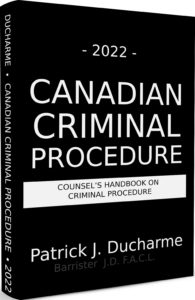
An objection to an indictment or to a count in an indictment for a defect apparent on the face of it, must be taken by motion to quash the indictment or count before the accused has pleaded and thereafter only by leave of the court. The court that receives the objection may, if it considers it necessary, order the indictment or count to be amended to cure the defect.1 When a count in an information or indictment is so deficient that the court quashes it, the order may, in effect, end the prosecution. It may end because the limitation period for prosecuting the offence has expired, or, because further prosecution may be stayed as an abuse of process pursuant to section 7 of the Charter, or, based on unreasonable delay pursuant to section 11(b) of the Charter.
The recent trend in law, however, is not to quash but to amend. The strict rules of pleading in criminal law have given way to a less rigid interpretation of those rules, as evidenced by many recent cases rejecting objections based on duplicity and the single transaction rule. A Justice presiding at a preliminary inquiry may now also make amendments pursuant to subsection 601(11) of the Code.
The court may also “fix” otherwise objectionable informations or indictments by ordering the Crown to produce “particulars” pursuant to section 587 of the Code. An amendment cannot, however, substitute an entirely different offence for the one originally charged.3 A count that is duplicitous (or multifarious) may be amended.4 In considering whether or not to amend the court must consider:
The matters disclosed by the evidence taken at the preliminary inquiry;
The evidence taken on the trial, if any;
The circumstances of the case;
Whether the accused has been misled or prejudiced in his defence by any variation, error or omission; and
Whether, having regard to the merits of the case, the proposed amendment can be made without injustice being done.
It is important to remember that a motion to quash must be brought prior to plea, otherwise the applicant will be at the mercy of the court to grant leave to argue the motion. If the court does quash an indictable offence that does not have a limitation period, subject only to a finding of abuse or an infringement the constitutional right to a trial within a reasonable time, the Crown may relay the charge. In addition, if the Crown relays the charge, the accused will not be able to argue autrefois acquit. If an accused’s application to quash is dismissed, based upon a question of law, the legal issue may be raised on any subsequent appeal.
Amendments may be requested to cure defects that are apparent on the face of the indictment, and, amendments may also be permitted where the evidence deviates from the allegations within the information or indictment. The court is provided with discretion to amend defects that emerge during the course of the trial. If an amendment can be made without prejudice to the accused it will usually be made.7 This affects the timing of an amendment.
An amendment for a defect on the face of the indictment may be made at any time. An amendment for a variance of evidence and charge, may lead the Judge to find it advisable to consider the amendment request only after the evidence has been presented.8 A trial Judge may, on her own motion, amend an information to conform with the evidence.9 The trial Judge, however, is under no duty to amend an information on her own motion in the absence of an application to amend by the Crown.10

The above is the an excerpt of Patrick J Ducharme’s book, Canadian Criminal Procedure, available at Amazon or in bulk through MedicaLegal Publishing along with Criminal Trial Strategies.
Subscribe to Patrick Ducharme’s Youtube Channel
